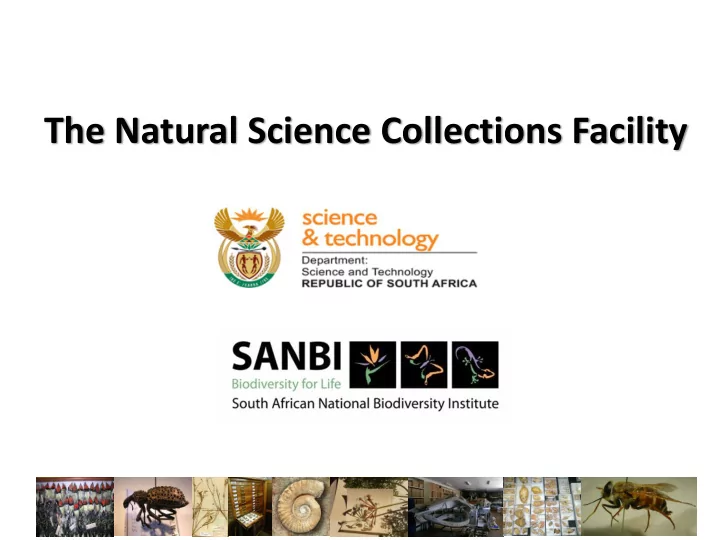

The Natural Science Collections Facility
Natural Science Collections
Collections in South Africa • Over 80 different institutions hold natural science collections (eg. ARC, SANBI, SAIAB, 11 museums (national, provincial and one municipal), most universities, conservation agencies • Total of more than 140 different collections with >30 million specimens / samples
The South African Research Infrastructure Roadmap Seven RIs were selected by DST for implementation in 2017: 1. The SA Network of Health and Demographic Surveillance Sites 2. National Centre for Digital Language Resources (NCDLR) 3. Distributed Platform for “Omics” Research ( Diplomics) 4. An expanded National Terrestrial Environmental Observation Network 5. Shallow Marine and Coastal Research Infrastructure 6. Natural Sciences Collection Facility 7. Nuclear medicine DST have provided R51 million over 3 years for the NSCF
What are critical criteria for RIs? • Research Infrastructure (RI) must be used by the scientific community for conducting cutting edge research for the generation, exchange and preservation of knowledge. A national RI is a service to research which: • Must be openly accessible to researchers • Data must be made openly accessible • Must be used for training and capacity development • Must address national priorities
The Natural Science Collections Facility Challenge of transforming highly fragmented landscape, with many staffing and resourcing challenges that date back many years … to meet RI requirements
Iziko WITS Museum UKZN Natural Herbarium National Herbaria Sciences ARC: Museum National Natural Collections Sciences SANBI SAIAB Central Herbaria Co-ordinating Hub - SANBI Ditsong Museum Eastern Cape Natural Natural Science Sciences Museums Durban Natural KZN WITS Science Museum UCT Bolus Palaeont Museums Herbarium -ology
Overall aim of the NSCF To ensure that collections contribute, through high quality research and data, to addressing issues of socio-economic importance
Objectives (red=data related): 1. Collections secure and accessible for research (physical and virtual collection – imaging of specimens, scanning of field notes, accession registers ) 2. Database of collections accessible and used for managing collections, research and decision-making 3. Collections and data are used for research th at addresses issues of national and global relevance 4. Collections are used as a reference for providing services to identify biological specimens 5. Collections valued for serving society through education, citizen science and public understanding projects
Current situation: total = +12 million specimens / specimen lots in 40 institutions; 5 million records in databases 9000000 8000000 Number of Specimens 7000000 6000000 5000000 not databased 4000000 databased 3000000 2000000 1000000 0 Plants Animals Rocks and fossils
Current situation Challenges with software – wide range used with variation even in same institution Data quality: • challenges with names / identifications (outdated or missing or incorrect) • locality data and georeferencing - gaps, missing, inaccurate • metadata – generally missing Procedures, standards and guidelines – generally lacking Capacity – major constraint (people and skills) Images and scans of documents - no standards or systems; most documents have no digital version or even copies
Plans for the next 3 years • Common standards, procedures and workflows for data • Migration to standard software (BRAHMS, Specify) • Upgrading of data sets: vertebrates, macrofungi, Karoo fossils, 2 plant families (verification (including taxonomic / identification), georeferencing, cleaning) • Imaging of type specimens for the same groups – virtual collection • Scanning of accession registers, field notes • Capacity development – staff at institutions and contract staff appointed
Resources • Data Working Group with representatives from institutions – provide input, take decisions back to institutions for implementation • Working Group Co-ordinator – lead development of documents, and implementation of plans • SANBI BIM staff – vast experience with BRAHMS • SAIAB expertise and other expertise at institutions and access to server space for Specify • BHL – link to expertise and equipment for document scanning • Contract staff to assist with data upgrading, imaging of specimens and scanning of documents • Contract specialists for assistance with training and data migration to Specify.
Thanks • We are very grateful to DST for recognising the collections as important research infrastructure • Thanks to the collection institutions that are participating, and those that have offered their resources to the Facility. • We welcome suggestions!!
Recommend
More recommend